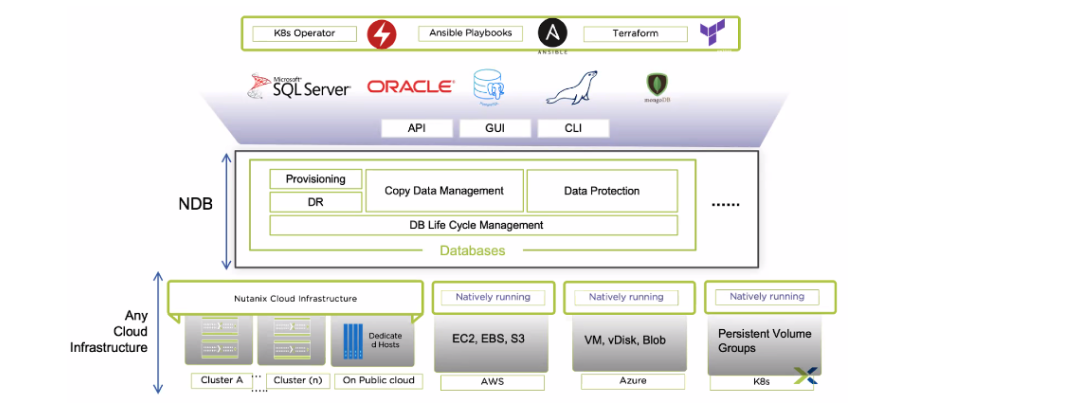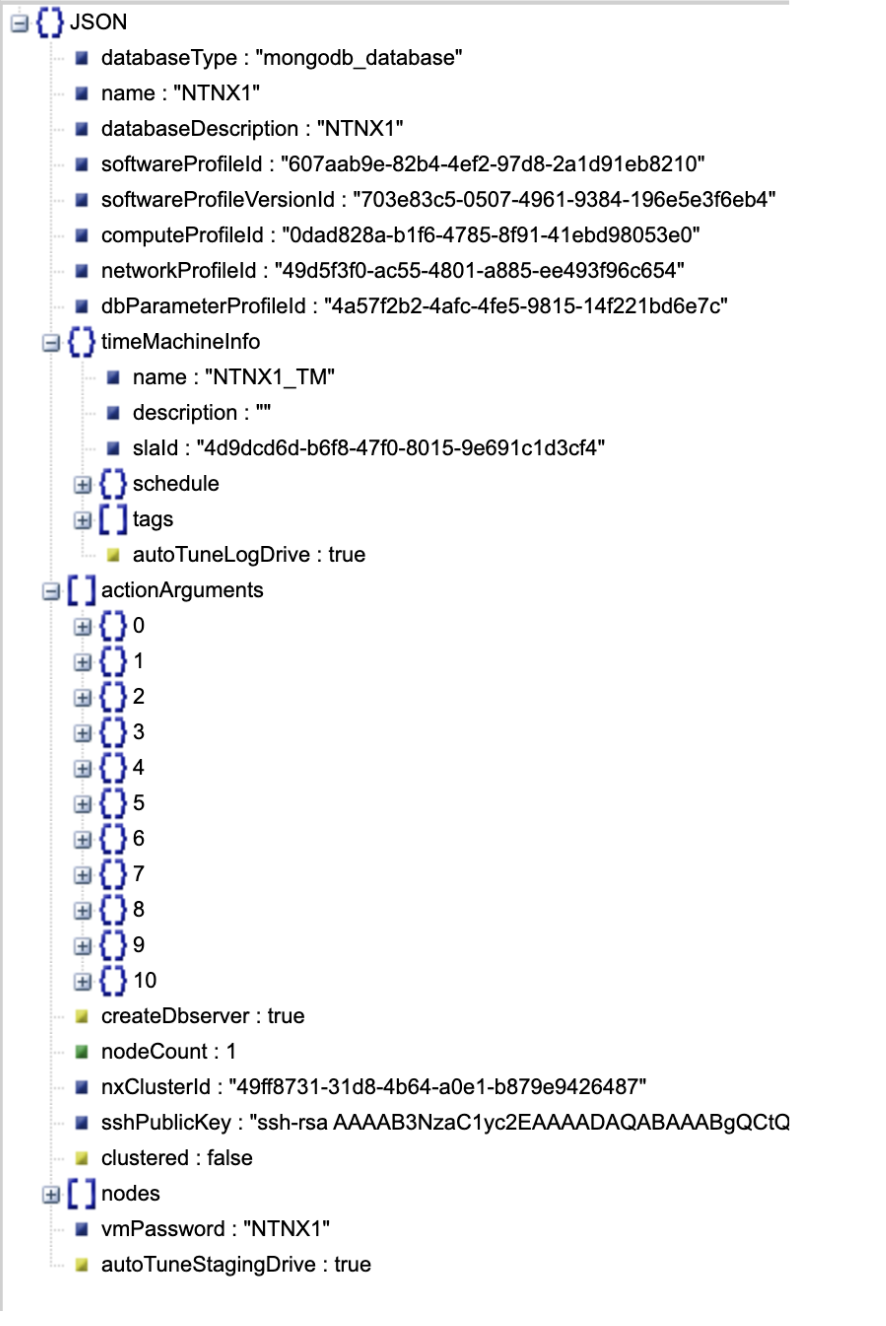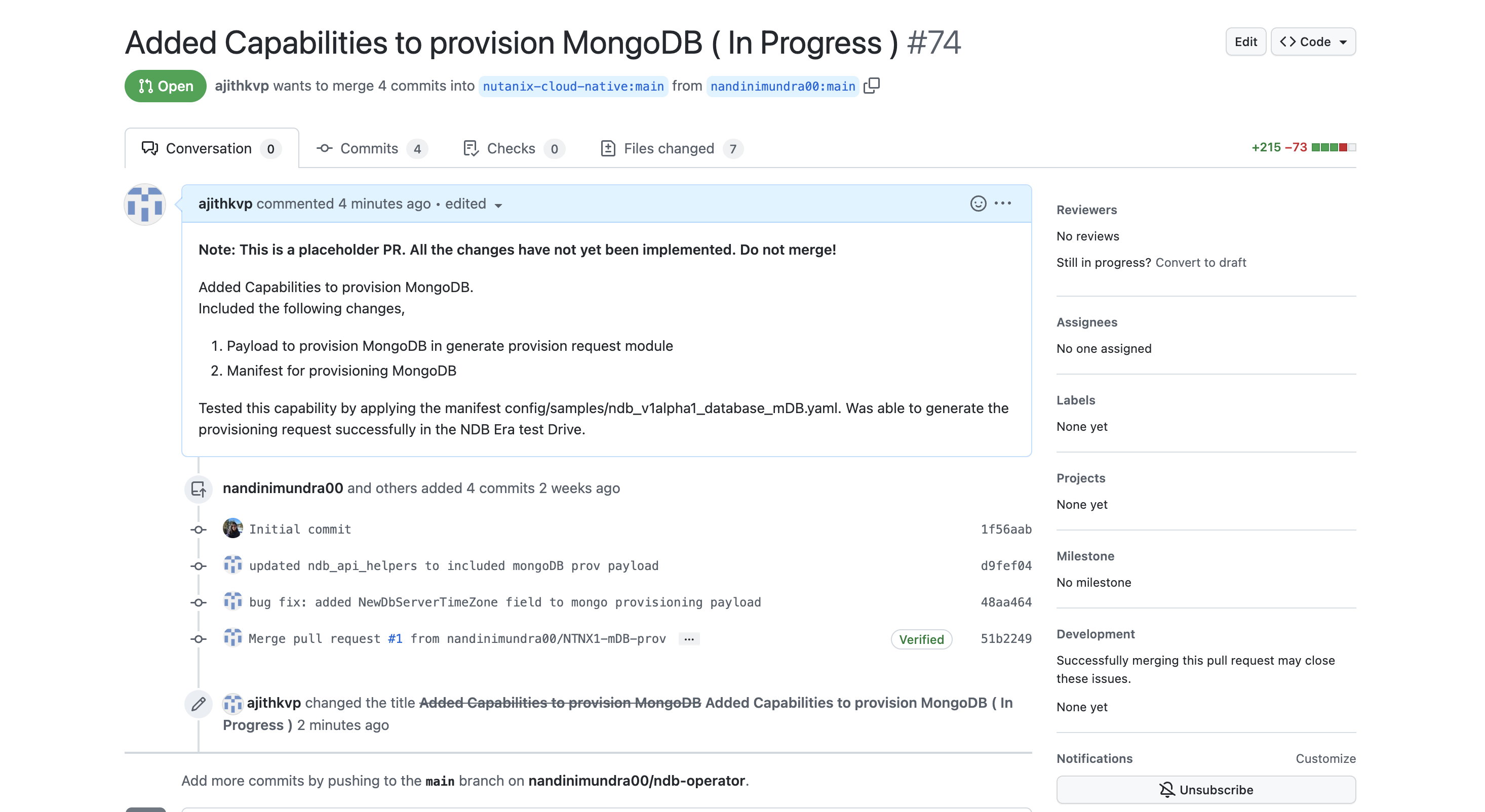CSC/ECE 517 Spring 2023 - NTNX-3. Refactor models to keep profiles (software, compute, network, etc) as optional and use default if not specified: Difference between revisions
| Line 34: | Line 34: | ||
[[File:SS_2.png|1000px]] | [[File:SS_2.png|1000px]] | ||
Microsoft SQL Server, Oracle Database, PostgreSQL, MySQL, and MongoDB are just a few of the databases that can have high availability, scalability, and speed thanks to the distributed architecture of the Nutanix Database Service. The hyper-converged infrastructure from Nutanix, which offers a scalable and adaptable platform for handling enterprise workloads, is the foundation around which the architecture is built. | |||
There are various layers in the architecture of the Nutanix Database Service. The Nutanix hyperconverged infrastructure is the basic layer that provides the storage, computing, and networking resources needed to run the databases. The Nutanix Acropolis operating system, which offers the essential virtualization and administration features, sits on top of this layer. | |||
The Nutanix Era layer, which is located above the Nutanix Acropolis layer, offers the Nutanix Database Service the ability to manage databases throughout their existence. The Nutanix Era Manager, a centralized management console that offers a single point of access for controlling the databases across several clouds and data centers, is included in this tier. | |||
The | The Nutanix Era Orchestrator, which is in charge of automating the provisioning, scaling, patching, and backup of the databases, is another component of the Nutanix Era layer. The Orchestrator offers a declarative approach for specifying the desired state of the databases and is built to work with a variety of databases. | ||
The Nutanix Era Application, a web-based interface that enables database administrators and developers to quickly provision and administer the databases, is the final component of the top layer. A self-service interface for installing databases as well as a number of tools for tracking and troubleshooting database performance are offered by the Era Application. | |||
==Design & Workflow== | ==Design & Workflow== | ||
Revision as of 00:39, 26 March 2023
Background
Kubernetes An open-source container orchestration technology called Kubernetes is used to automatically deploy, scale, and manage containerized applications. Developers can use Kubernetes to distribute and control containerized applications across a dispersed network of servers or PCs. To ensure that the actual state of an application matches the desired state, it uses a declarative model to express the desired state and automatically manages the containerized components. Kubernetes can be operated on public or private cloud infrastructure as well as in-house data centers and offers a wide range of functionality for managing containerized applications, such as autonomous scaling, rolling updates, self-healing, service discovery, and load balancing.
Nutanix Database Service
A hybrid multi-cloud database-as-a-service for Microsoft SQL Server, Oracle Database, PostgreSQL, MongoDB, and MySQL, among other databases, is called Nutanix Database Service. It allows for the efficient management of hundreds to thousands of databases, the quick creation of new ones, and the automation of time-consuming administration activities like patching and backups. Users can also choose certain operating systems, database versions, and extensions to satisfy application and compliance requirements. Customers from all around the world have optimized their databases across numerous locations and sped up software development using Nutanix Database Service.
Features offered by NDB Service:
- It enables users to manage the complete database lifecycle, including database provisioning, scaling, version upgrades, and patch automation.
- The product allows users to manage hundreds to thousands of databases, such as Microsoft SQL Server, Oracle, PostgreSQL, MySQL, and MongoDB, across various platforms, including on-premises, colocation facilities, and multiple public clouds, all from a single control point.
- Users can provision databases for both dev/test and production purposes through API integration with infrastructure management and development tools, such as ServiceNow.
- The product enables users to quickly deploy patches across some or all of their databases to prevent the latest security threats. Additionally, it provides role-based access controls to restrict access to databases, ensuring compliance with regulatory requirements and best practices.
- It also provides features for data protection, compliance, and security, including data encryption, role-based access control, and audit logging.
- It integrates with popular DevOps tools like Ansible, Jenkins, and Terraform to automate the deployment and management of databases.
NDB Kubernetes Operator
A tool that makes it easier to deploy and administer open-source databases on Kubernetes is the NDB Kubernetes operator. It enables users to declaratively deploy and manage well-known databases like MySQL, PostgreSQL, and MariaDB on Kubernetes. That is one method of using the NDB service. The purpose of Kubernetes is to manage stateless objects. We needed an operator since NDB must be handled in a very specific manner.
The NDB Kubernetes Operator makes it simpler to manage databases in a Kubernetes environment by automating database deployment, scaling, backup, recovery, and monitoring. To automate the deployment and management of databases, it also connects with well-known DevOps tools like Ansible, Jenkins, and Terraform. It enables users to take advantage of Kubernetes' advantages, such as load balancing, service discovery, self-healing, rolling updates, and automatic scaling.
Developers and DevOps teams can concentrate on the high-level features of their applications rather than the low-level intricacies of managing databases using the NDB Kubernetes Operator, which makes application deployment and maintenance more scalable and dependable.
Existing Architecture and Problem Statement
Problem Statement: Refactor models to keep profiles (software, compute, network, etc) as optional and use default if not specified
The NDB Kubernetes operator currently uses default compute, network and OS software profiles while provisioning the database. Refactor this module to include optional fields and only if absent, fall back to default.
NDB Architecture
Microsoft SQL Server, Oracle Database, PostgreSQL, MySQL, and MongoDB are just a few of the databases that can have high availability, scalability, and speed thanks to the distributed architecture of the Nutanix Database Service. The hyper-converged infrastructure from Nutanix, which offers a scalable and adaptable platform for handling enterprise workloads, is the foundation around which the architecture is built.
There are various layers in the architecture of the Nutanix Database Service. The Nutanix hyperconverged infrastructure is the basic layer that provides the storage, computing, and networking resources needed to run the databases. The Nutanix Acropolis operating system, which offers the essential virtualization and administration features, sits on top of this layer.
The Nutanix Era layer, which is located above the Nutanix Acropolis layer, offers the Nutanix Database Service the ability to manage databases throughout their existence. The Nutanix Era Manager, a centralized management console that offers a single point of access for controlling the databases across several clouds and data centers, is included in this tier.
The Nutanix Era Orchestrator, which is in charge of automating the provisioning, scaling, patching, and backup of the databases, is another component of the Nutanix Era layer. The Orchestrator offers a declarative approach for specifying the desired state of the databases and is built to work with a variety of databases.
The Nutanix Era Application, a web-based interface that enables database administrators and developers to quickly provision and administer the databases, is the final component of the top layer. A self-service interface for installing databases as well as a number of tools for tracking and troubleshooting database performance are offered by the Era Application.
Design & Workflow
One of the biggest bottlenecks in connecting a database provisioned by the operator to an application is automatically sharing the database instance's connection details with the application. While sharing the username and password is relatively simple, sharing the database instance host IP with the application pod can be more complicated as the IP is assigned after the database is provisioned. To address this, there are two potential methods: creating a K8s service that maps to the external NDB service endpoint once the database instance is provisioned or creating a configmap with the IP for the database and referencing the configmap in the application pod.
In terms of making the application wait for the database before starting up, there are three options: handling the wait in the application logic (not recommended), failing the application and hence the pod in case of a database connection failure so that Kubernetes can attempt to restart the application pod until it succeeds, or using init-containers to wait on a Kubernetes pod or service.
Out of these options, creating a K8s service that maps to the external NDB service endpoint is the preferred method and is recommended by Google Cloud's Kubernetes Best Practices. This method provides a decoupling between the database instance and the application pod, and an init-container can wait for the service to be ready and start up the application container only after the service and the underlying database instance on NDB are available. Using these two mechanisms together can enable automatic connectivity between the database instance and the application pod(s).
We will be following the Kubernetes Operator Pattern in the project.
The Kubernetes operator pattern is a way to extend the Kubernetes API by defining custom resources and controllers that manage those resources. Operators automate common deployment, scaling, and management tasks for complex applications, such as databases, message queues, and monitoring systems, that require more than just creating a set of pods.
Here are the key components of the Kubernetes operator pattern:
- Custom resource definition (CRD): A CRD defines a new type of Kubernetes resource that can be managed by an operator. The CRD specifies the API schema and validation rules for the custom resource.
The snippet above shows the configuration of the custom resources we will be provisioning. The server URL and cluster changes every time a new era test drive is created, since a single test drive can only last for a maximum of four hours. This will supposedly provision a MongoDB database on the Nutanix Database Service.
- Controller: A controller watches for changes to the custom resources and takes actions to ensure the desired state of the resources is maintained. The controller reconciles the actual state of the resources with the desired state by interacting with the Kubernetes API server and other APIs, such as cloud providers or external systems.
- Operator business logic: The operator business logic implements the custom behavior required to manage the custom resources. This can include creating and deleting Kubernetes resources, interacting with external systems, performing backups and restores, and handling failure scenarios.
- Domain-specific language (DSL): A DSL provides an abstraction layer that simplifies the implementation of the operator business logic. DSLs can be created using a range of programming languages or tools, such as Ansible or Helm, to express the specific requirements of the target system.
The Kubernetes operator pattern is a powerful way to automate complex tasks and simplify the management of applications running in Kubernetes clusters. By using custom resources and controllers, operators can help you automate tasks like backups, scaling, and failover, freeing up time and resources to focus on higher-level tasks.
MongoDB provisioning payload:
The image above shows the MongoDB provisioning payload - which will be sent to the Nutanix Database Service client API for provisioning a Mongo database.
Potential Design Patterns, Principles, and Code Refactoring strategies
The codebase could be converted into an Object Oriented fashion with classes. Further, here are some of the design patterns we could use:
Builder: For any objects that are created, we could instantiate using say method chaining rather than initializing everything with a constructor.
Factory: Instead of using the regular way (such as the ‘new’ keyword) to instantiate an object, a factory method would be used to do the same. This pattern can be used if we are creating a superclass for provisioning databases, and subclasses for provisioning different kinds of databases (MongoDB, MySQL, etc). This is because if we want to add another kind of database to our project, and we are creating new databases by conditional checking, our code could get messy. Thus, a factory method could instead create objects in a smarter way for the different database classes (or modules in our case).
Facade: This pattern could be used for masking the complicated provisioning payloads.
Open and Closed principle: As per this principle, an interface is open for extension but closed for modification. We could have an interface with provisioning and deprovisioning methods, and interfaces of different databases could extend and reimplement those methods.
Adapter design pattern could also be added to adapt to different databases
DRY(Don’t repeat yourself): There are a lot of ways in which DRY principles will be applied in our project:
- Reusing the provisioning function
- Using constants instead of variables
- Extracting all common functionality into reusable modules and functions.
Demo
Here is the demo video for the developed infra:
https://www.youtube.com/watch?v=lUarCdA8RP0
Tests
Here is the video for test execution:
https://www.youtube.com/watch?v=O9Z9ypvQJDM
Here’s an example test for GeneratingProvisioningRequest.
The purpose of the test is to verify that the function generates a valid provisioning request for different database types. The test sets up a test server using the GetServerTestHelper function, creates a ndbclient object, and then iterates over a list of database types (PostgreSQL, MySQL, and MongoDB).
For each database type, the test creates a dbSpec object that defines the desired state of the database instance. It then creates a reqData map that specifies additional provisioning request parameters such as the password and SSH public key. The GenerateProvisioningRequest function is called with the ndbclient, dbSpec, and reqData arguments to generate the actual provisioning request.
The test then checks that the generated request is valid by asserting that the DatabaseType field matches the expected value for the given database type. It also checks that the SoftwareProfileId, SoftwareProfileVersionId, ComputeProfileId, NetworkProfileId, and DbParameterProfileId fields are not empty, and that the TimeMachineInfo.SlaId field is set to NONE_SLA_ID. If any of the assertions fail, the test logs an error message using the t.Errorf or t.Logf functions, indicating which specific assertion failed.
There are also many tests that are handling a lot of niche functionality with regards to generating the provisioning request. For instance, TestGenerateProvisioningRequestReturnsErrorIfDBPasswordIsEmpty is one. It ensures that the function returns an error when the db password parameter is empty. The test sets up an HTTP server, creates an instance of an ndbclient, and then generates a provisioning request with an empty database password for three different database types: postgres, mysql, and mongodb. If the function GenerateProvisioningRequest returns no error, the test fails with an error message.
Github
- Repo: https://github.com/karan-47/ndb-operator/tree/feature/ntnx_3
- Pull Request: https://github.com/nutanix-cloud-native/ndb-operator/pull/74
Mentors
- Prof. Edward F. Gehringer
- Krunal Jhaveri
- Manav Rajvanshi
- Krishna Saurabh Vankadaru
- Kartiki Bhandakkar
Contributors
- Karan Pradeep Gala (kgala2)
- Ashish Joshi (ajoshi24)
- Tilak Satra (trsatra)
References
[1] Nutanix. (n.d.). Nutanix Database Service. Retrieved from https://www.nutanix.com/products/database-service
[2] Kubernetes Operator Pattern https://kubernetes.io/docs/concepts/extend-kubernetes/operator







